The packaging burst strength test market is valued at USD 397.4 million in 2025 and projected to reach USD 732.1 million by 2035, growing at a CAGR of 6.3%. A saturation point analysis indicates that the market is still in the early-to-mid growth stage, with consistent revenue expansion from USD 292.8 million in 2020 to USD 397.4 million in 2025.
At this phase, adoption is driven by rising demand for stronger packaging materials in food, beverage, and e-commerce supply chains. No saturation pressure is evident yet, as increasing global trade volumes and stricter quality compliance requirements continue to fuel steady growth.
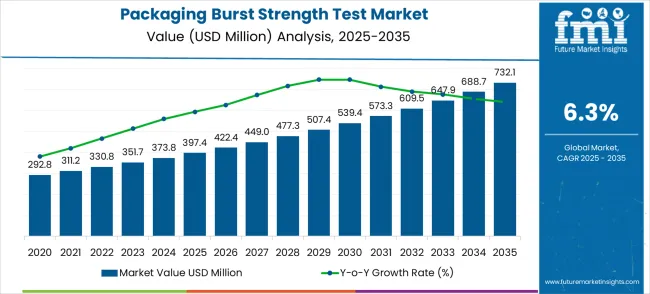
Between 2025 and 2030, revenue climbs from USD 397.4 million to USD 539.4 million, marking an intermediate stage of expansion. During this phase, adoption broadens into more industries, including pharmaceuticals, personal care, and industrial packaging, reinforcing the need for reliable strength testing.
The growth pattern reflects momentum but also signals the beginning of a gradual approach toward maturity. The market is not yet nearing saturation, though incremental gains are more consistent than exponential, reflecting wider but steady penetration. This stage highlights the shift from early adoption to mainstream integration of burst strength testing systems.
From 2030 to 2035, the market rises from USD 539.4 million to USD 732.1 million, showing continued growth but with signs of eventual slowing. By this stage, most large-scale manufacturers and distributors will have already integrated burst strength testing into their quality control systems.
Expansion is driven largely by replacement demand, incremental upgrades, and geographic adoption in developing regions. While CAGR remains healthy, the saturation point is expected to begin forming beyond 2035 as adoption reaches maturity. This indicates that the market’s growth potential will gradually stabilize, shifting from rapid expansion to a cycle of consistent but moderate replacement-driven revenues.
| Metric | Value |
|---|---|
| Market Value (2025) | USD 397.4 million |
| Market Forecast Value (2035) | USD 732.1 million |
| Market Forecast CAGR | 6.3% |
Market expansion is being supported by the rapid increase in e-commerce packaging demands worldwide and the corresponding need for comprehensive testing solutions that provide superior material validation capabilities and quality assurance reliability for critical packaging and logistics applications. Modern packaging manufacturers and logistics companies rely on consistent material performance verification and durability assessment to ensure optimal package integrity including shipping damage prevention, material optimization, and customer satisfaction maintenance. Even minor packaging failures can require comprehensive material redesign procedures to maintain optimal performance standards and brand protection.
The growing complexity of packaging material requirements and increasing demand for sustainable packaging validation are driving demand for burst strength testing services from certified laboratories with appropriate testing capabilities and technical expertise. Packaging engineers are increasingly requiring documented performance specifications and durability standards to maintain material quality and regulatory compliance. Industry standards and certification requirements are establishing standardized testing procedures that require specialized burst strength technologies and trained testing personnel.
The Packaging Burst Strength Test market is entering a sustained growth phase, driven by demand for quality assurance, e-commerce expansion, and evolving packaging performance and sustainability standards. By 2035, these pathways together can unlock USD 200-250 million in incremental revenue opportunities beyond baseline growth.
Pathway A -- Material Focus Leadership (Paper-Based Testing) The paper-based testing segment already holds the largest share due to its sustainability and widespread use. Expanding testing methodologies, automation capabilities, and standard development can consolidate leadership. Opportunity pool: USD 50-65 million.
Pathway B -- Core Industry Applications (Logistics & Shipping) Logistics accounts for the largest demand. Growing e-commerce infrastructure and last-mile delivery expansion, especially in emerging economies, will drive higher adoption of burst strength testing for package optimization. Opportunity pool: USD 45-55 million.
Pathway C -- Food Packaging Expansion (Safety & Compliance) Food packaging applications represent significant growth potential with increasing safety requirements. Testing optimized for food-grade materials and regulatory compliance can capture substantial growth. Opportunity pool: USD 35-45 million.
Pathway D -- Emerging Market Expansion Asia-Pacific and Latin America present growing demand due to manufacturing growth. Targeting cost-effective testing solutions and local partnerships will accelerate adoption. Opportunity pool: USD 25-35 million.
Pathway E -- Medical Packaging Integration with increasing healthcare packaging requirements, there is an opportunity to promote testing optimized for pharmaceutical and medical device packaging validation. Opportunity pool: USD 20-25 million.
Pathway F -- Specialized Applications (Sustainable Materials) Testing optimized for biodegradable materials, recycled content packaging, and innovative sustainable solutions offer premium positioning for eco-conscious sectors. Opportunity pool: USD 15-20 million.
Pathway G -- Testing Services & Consulting Recurring revenue from consulting services, material optimization guidance, and packaging design support creates long-term engagement streams. Opportunity pool: USD 8-12 million.
Pathway H -- Digital Integration & IoT Monitoring Smart testing systems, real-time quality monitoring, and connected quality management can elevate testing into comprehensive packaging optimization solutions. Opportunity pool: USD 2-8 million.
The market is segmented by material type, application, and region. By material type, the market is divided into paper-based material testing, plastic film testing, composite material testing, and other material validation services. Based on application, the market is categorized into logistics, food packaging, medical packaging, and other applications. Regionally, the market is divided into North America, Europe, East Asia, South Asia & Pacific, Latin America, and Middle East & Africa.
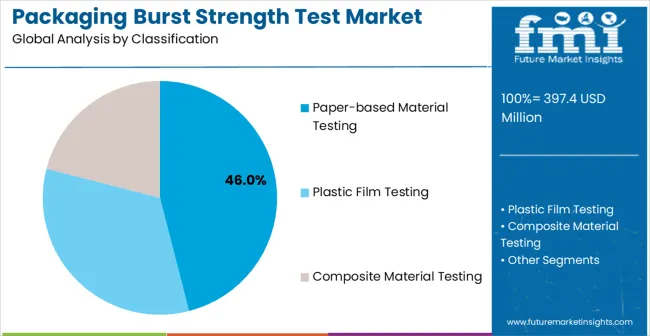
In 2025, the paper-based material testing segment is projected to capture around 46% of the total market share, making it the leading material type category. This dominance is largely driven by the widespread adoption of corrugated cardboard and paperboard packaging solutions that provide optimal balance between sustainability and performance capability, catering to a wide variety of e-commerce and shipping applications.
Paper-based material testing is particularly favored for its ability to validate superior structural integrity and compression resistance in both retail packaging and industrial shipping installations, ensuring package durability and cost-effective material utilization. E-commerce companies, logistics providers, food packaging manufacturers, and retail packaging applications increasingly prefer this testing focus, as it meets demanding performance requirements without imposing excessive material costs or environmental impact concerns.
The availability of well-established testing standards, along with comprehensive regulatory frameworks and standardized test methods from international organizations, further reinforces the segment's market position.
Additionally, this material type category benefits from consistent demand across industries, as it is considered an essential and sustainable solution for applications requiring reliable packaging performance and environmental responsibility. The combination of sustainability benefits, cost optimization, and performance reliability makes paper-based material testing a critical choice, ensuring their continued dominance in the packaging validation and logistics markets.
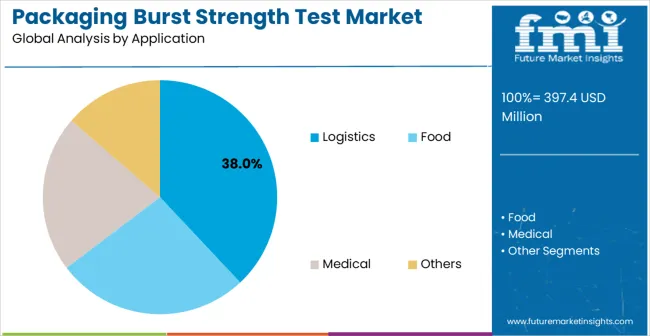
The logistics segment is expected to represent 38% of packaging burst strength test demand in 2025, highlighting its position as the most significant application sector. This dominance stems from the critical performance requirements of modern logistics operations, where package integrity and damage prevention are essential to operational efficiency and customer satisfaction.
Logistics networks often feature extensive handling and transportation processes that demand specialized burst strength validation throughout complex distribution systems, requiring reliable and comprehensive testing protocols.
Packaging burst strength testing is particularly well-suited to these environments due to its ability to provide consistent damage prediction and material performance validation, even during intensive handling operations and varying transportation conditions. As e-commerce continues to expand globally and emphasizes improved delivery experience standards, the demand for packaging burst strength testing continues to rise.
The segment also benefits from heightened quality requirements within the logistics industry, where operators are increasingly prioritizing package durability and damage prevention as essential operational measures. With logistics companies investing in advanced packaging optimization and damage reduction technologies, burst strength testing provides an essential component to maintain high-performance delivery standards and customer satisfaction.
The growth of last-mile delivery and omnichannel distribution, coupled with increased focus on packaging efficiency standards, ensures that logistics will remain the largest and most stable demand driver for packaging burst strength testing in the forecast period.
The Packaging Burst Strength Test market is advancing rapidly due to increasing e-commerce growth and growing recognition of packaging testing advantages over traditional quality control methods in damage prevention applications.
However, the market faces challenges including higher testing costs compared to basic quality checks, need for specialized equipment and technical expertise, and complex standardization requirements with varying test protocols across different material types and applications. Innovation optimization efforts and advanced testing automation programs continue to influence equipment development and market adoption patterns.
The growing development of advanced automated testing systems and enhanced measurement technologies is enabling superior testing accuracy with improved repeatability and reduced operator variability. Advanced automation applications and optimized testing protocols provide superior material validation while maintaining efficiency requirements. These technologies are particularly valuable for high-volume packaging manufacturers who require reliable testing capabilities that can support extensive quality control operations with consistent accurate results.
Modern packaging testing service providers are incorporating advanced data management capabilities and intelligent analytics systems that enhance testing efficiency and operational effectiveness. Integration of cloud-based data platforms and optimized reporting systems enables superior quality tracking and comprehensive material performance analysis capabilities. Advanced digital features support operation in diverse manufacturing environments while meeting various compliance requirements and traceability specifications.
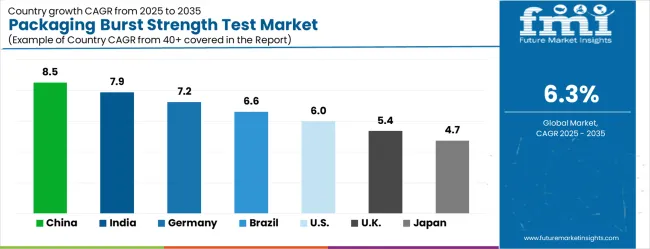
| Country | CAGR (2025-2035) |
|---|---|
| China | 8.5% |
| India | 7.9% |
| Germany | 7.2% |
| Brazil | 6.6% |
| United States | 6.0% |
| United Kingdom | 5.4% |
| Japan | 4.7% |
The packaging burst strength test market is growing steadily, with China leading at an 8.5% CAGR through 2035, driven by massive manufacturing expansion and increasing adoption of quality assurance testing solutions. India follows at 7.9%, supported by rising manufacturing standards and growing implementation of packaging validation technologies.
Germany grows strongly at 7.2%, integrating advanced testing technology into its established manufacturing sector. Brazil records 6.6%, emphasizing manufacturing infrastructure development and quality control modernization initiatives. The United States shows solid growth at 6.0%, focusing on e-commerce packaging optimization and testing innovation.
The United Kingdom demonstrates steady progress at 5.4%, maintaining established logistics applications. Japan records 4.7% growth, concentrating on technology advancement and quality assurance optimization.
The report covers an in-depth analysis of 40+ countries top-performing countries are highlighted below.
Packaging burst strength testing market in China is projected to exhibit the highest growth rate with a CAGR of 8.5% through 2035, driven by unprecedented manufacturing expansion and increasing demand for quality assurance testing solutions. The country's massive packaging industry and expanding e-commerce infrastructure are creating enormous demand for advanced testing service solutions.
Major manufacturing companies are establishing comprehensive quality control systems to support the increasing requirements of packaging companies and logistics service providers across metropolitan industrial zones.
Government manufacturing development initiatives are supporting establishment of quality assurance facilities and advanced testing technology complexes, driving demand for high-performance testing services throughout major manufacturing corridors. Manufacturing sector modernization programs are facilitating adoption of testing technologies that enhance quality control efficiency and product reliability standards across packaging infrastructure networks.
Packaging burst strength testing market in India is expanding at a CAGR of 7.9%, supported by increasing manufacturing standards and growing implementation of quality assurance technologies. The country's expanding manufacturing sector and rising quality control standards are driving demand for advanced testing service solutions. Manufacturing companies and logistics providers are gradually implementing high-performance testing equipment to maintain competitive standards and regulatory compliance.
Manufacturing sector growth and quality infrastructure development are creating opportunities for suppliers that can support diverse testing requirements and cost-effective specifications. Professional training and technical programs are building expertise among quality control personnel, enabling effective utilization of testing technology that meets industry standards and compliance requirements.
Packaging burst strength testing market in Germany is projected to grow at a CAGR of 7.2%, supported by the country's emphasis on manufacturing quality standards and advanced testing technology adoption. German manufacturing facilities and packaging companies are implementing sophisticated testing systems that meet stringent performance requirements and regulatory specifications. The market is characterized by focus on testing accuracy, quality assurance excellence, and compliance with comprehensive manufacturing standards.
Manufacturing industry investments are prioritizing cutting-edge testing technology that demonstrates superior performance and reliability while meeting German quality and efficiency standards. Professional certification programs are ensuring comprehensive technical expertise among quality control personnel, enabling specialized testing capabilities that support diverse manufacturing applications and regulatory requirements.
Packaging burst strength testing market in Brazil is growing at a CAGR of 6.6%, driven by increasing manufacturing infrastructure development and growing recognition of quality assurance testing advantages. The country's expanding manufacturing sector is gradually integrating advanced testing solutions to enhance product quality and regulatory compliance. Manufacturing facilities and packaging companies are investing in testing technology to address evolving quality requirements and competitive standards.
Manufacturing infrastructure modernization is facilitating adoption of advanced testing technologies that support comprehensive quality control capabilities across manufacturing regions. Professional development programs are enhancing technical capabilities among quality control personnel, enabling effective testing utilization that meets evolving manufacturing standards and performance requirements.
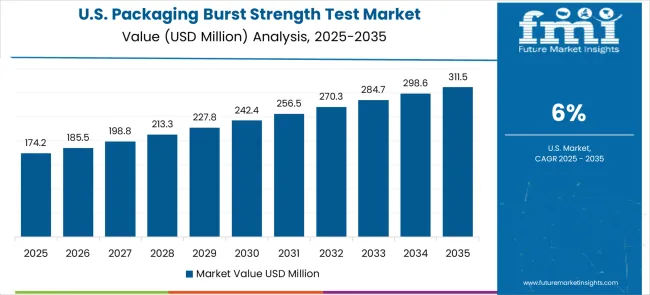
Demand for packaging burst strength testing in the USA is expanding at a CAGR of 6.0%, driven by established e-commerce industries and growing emphasis on packaging optimization. Large logistics companies and packaging manufacturers are implementing comprehensive testing capabilities to serve diverse quality assurance requirements. The market benefits from established logistics infrastructure distribution systems and professional development programs that support various e-commerce and manufacturing applications.
E-commerce industry leadership is enabling standardized testing utilization across multiple packaging types, providing consistent performance standards and comprehensive quality coverage throughout regional markets. Professional development and certification programs are building specialized technical expertise among quality control personnel, enabling effective testing utilization that supports evolving e-commerce and manufacturing requirements.
Demand for packaging burst strength testing in the UK is projected to grow at a CAGR of 5.4%, supported by established logistics sectors and growing emphasis on packaging performance capabilities. British logistics companies and packaging service providers are implementing testing systems that meet industry performance standards and operational requirements. The market benefits from established logistics infrastructure and comprehensive training programs for technical professionals.
Logistics facility investments are prioritizing advanced testing solutions that support diverse packaging applications while maintaining established performance and efficiency standards. Professional development programs are building technical expertise among quality control personnel, enabling specialized testing operation capabilities that meet evolving facility requirements and performance standards.
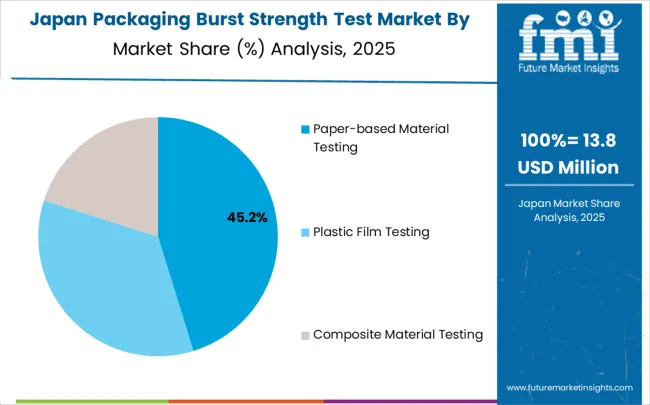
Packaging burst strength testing in Japan is growing at a CAGR of 4.7%, driven by the country's focus on manufacturing technology innovation and quality assurance applications. Japanese manufacturing facilities and packaging companies are implementing advanced testing systems that demonstrate superior performance reliability and operational consistency. The market is characterized by emphasis on technological excellence, quality assurance precision, and integration with established manufacturing workflows.
Manufacturing technology investments are prioritizing innovative testing solutions that combine advanced validation technology with precision measurement while maintaining Japanese quality and reliability standards. Professional development programs are ensuring comprehensive technical expertise among quality control personnel, enabling specialized testing capabilities that support diverse manufacturing applications and quality requirements.
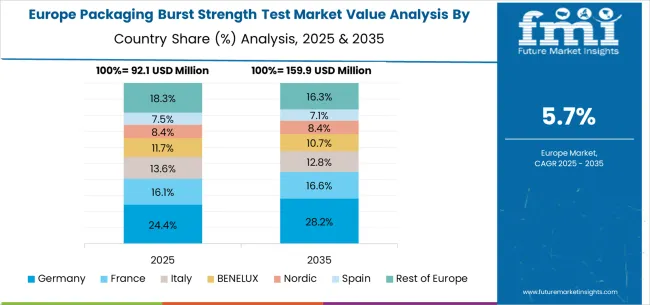
The packaging burst strength test market in Europe is forecast to expand from USD 104.0 million in 2025 to USD 191.6 million by 2035, registering a CAGR of 6.3%. Germany will remain the largest market, holding 30.8% share in 2025, easing to 30.2% by 2035, supported by strong manufacturing infrastructure and advanced testing standards.
The United Kingdom follows, rising from 22.1% in 2025 to 22.6% by 2035, driven by logistics facility modernization and quality assurance enhancement initiatives. France is expected to maintain stability from 17.7% to 17.4%, reflecting consistent manufacturing industry investments and testing requirements.
Italy holds around 13.2% throughout the forecast period, supported by manufacturing facility upgrades and quality control modernization programs. Spain grows from 9.5% to 9.8% with expanding manufacturing infrastructure and increased focus on packaging testing solutions. BENELUX markets maintain 4.2% to 4.0%, while the remainder of Europe hovers near 2.5%--2.5%, balancing emerging Eastern European manufacturing development against mature Nordic markets with established testing technology adoption patterns.
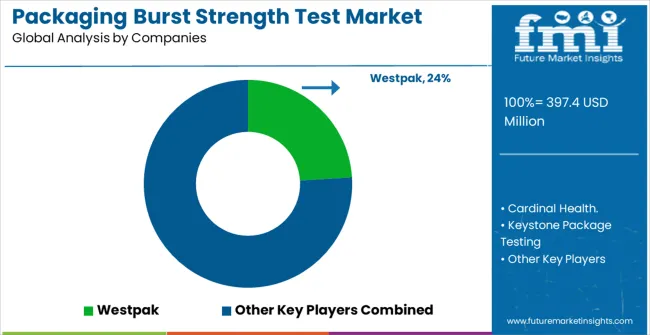
The Packaging Burst Strength Test market is defined by competition among specialized testing laboratories, packaging consulting companies, and quality assurance service providers. Companies are investing in advanced testing technology development, automation innovation, data analytics optimization, and comprehensive consulting service capabilities to deliver accurate, efficient, and cost-effective testing solutions. Strategic partnerships, technological innovation, and service expansion are central to strengthening service portfolios and market presence.
Westpak offers comprehensive packaging testing solutions with established laboratory expertise and professional-grade validation capabilities. Cardinal Health provides specialized healthcare packaging testing with focus on regulatory compliance and operational safety. Keystone Package Testing delivers advanced testing services with emphasis on accuracy optimization and client-friendly reporting. Japan Business Logistics Co., Ltd. specializes in logistics-focused testing with advanced material evaluation capabilities.
Smithers offers professional-grade testing equipment with comprehensive technical consulting capabilities. TEN-E Packaging Services delivers established testing solutions with advanced automation technologies. Xometry provides specialized testing platforms with focus on digital integration. DDL, Inc., Nelson Labs, Kalite, LOGISTEED, Ltd., Nihontmc, MM Group, Infinity Laboratories, and Steris offer specialized laboratory expertise, testing reliability, and comprehensive development across global and regional packaging market segments.
| Item | Value |
|---|---|
| Quantitative Units | USD 397.4 million |
| Material Type | Paper-based Material Testing, Plastic Film Testing, Composite Material Testing |
| Application | Logistics, Food, Medical, Others |
| Regions Covered | North America, Europe, East Asia, South Asia & Pacific, Latin America, Middle East & Africa |
| Country Covered | China, India, Germany, Brazil, United States, United Kingdom, Japan, and 40+ countries |
| Key Companies Profiled | Westpak, Cardinal Health, Keystone Package Testing, Japan Business Logistics Co., Ltd., Smithers, TEN-E Packaging Services, Inc., Xometry, DDL, Inc., Nelson Labs, Kalite, LOGISTEED, Ltd., Nihontmc, MM Group, Infinity Laboratories, Steris |
| Additional Attributes | Dollar sales by material type and application segment, regional demand trends across major markets, competitive landscape with established testing laboratories and emerging service providers, customer preferences for different testing configurations and reporting options, integration with quality management systems and compliance protocols, innovations in testing technology and automation efficiency, and adoption of advanced digital features with enhanced data analytics capabilities for improved quality assurance workflows. |
The global packaging burst strength test market is estimated to be valued at USD 397.4 million in 2025.
The market size for the packaging burst strength test market is projected to reach USD 732.1 million by 2035.
The packaging burst strength test market is expected to grow at a 6.3% CAGR between 2025 and 2035.
The key product types in packaging burst strength test market are paper-based material testing, plastic film testing and composite material testing.
In terms of application, logistics segment to command 38.0% share in the packaging burst strength test market in 2025.






Our Research Products

The "Full Research Suite" delivers actionable market intel, deep dives on markets or technologies, so clients act faster, cut risk, and unlock growth.

The Leaderboard benchmarks and ranks top vendors, classifying them as Established Leaders, Leading Challengers, or Disruptors & Challengers.

Locates where complements amplify value and substitutes erode it, forecasting net impact by horizon

We deliver granular, decision-grade intel: market sizing, 5-year forecasts, pricing, adoption, usage, revenue, and operational KPIs—plus competitor tracking, regulation, and value chains—across 60 countries broadly.

Spot the shifts before they hit your P&L. We track inflection points, adoption curves, pricing moves, and ecosystem plays to show where demand is heading, why it is changing, and what to do next across high-growth markets and disruptive tech

Real-time reads of user behavior. We track shifting priorities, perceptions of today’s and next-gen services, and provider experience, then pace how fast tech moves from trial to adoption, blending buyer, consumer, and channel inputs with social signals (#WhySwitch, #UX).

Partner with our analyst team to build a custom report designed around your business priorities. From analysing market trends to assessing competitors or crafting bespoke datasets, we tailor insights to your needs.
Supplier Intelligence
Discovery & Profiling
Capacity & Footprint
Performance & Risk
Compliance & Governance
Commercial Readiness
Who Supplies Whom
Scorecards & Shortlists
Playbooks & Docs
Category Intelligence
Definition & Scope
Demand & Use Cases
Cost Drivers
Market Structure
Supply Chain Map
Trade & Policy
Operating Norms
Deliverables
Buyer Intelligence
Account Basics
Spend & Scope
Procurement Model
Vendor Requirements
Terms & Policies
Entry Strategy
Pain Points & Triggers
Outputs
Pricing Analysis
Benchmarks
Trends
Should-Cost
Indexation
Landed Cost
Commercial Terms
Deliverables
Brand Analysis
Positioning & Value Prop
Share & Presence
Customer Evidence
Go-to-Market
Digital & Reputation
Compliance & Trust
KPIs & Gaps
Outputs
Full Research Suite comprises of:
Market outlook & trends analysis
Interviews & case studies
Strategic recommendations
Vendor profiles & capabilities analysis
5-year forecasts
8 regions and 60+ country-level data splits
Market segment data splits
12 months of continuous data updates
DELIVERED AS:
PDF EXCEL ONLINE
Packaging Supply Market Size and Share Forecast Outlook 2025 to 2035
Packaging Tubes Market Size and Share Forecast Outlook 2025 to 2035
Packaging Jar Market Forecast and Outlook 2025 to 2035
Packaging Barrier Film Market Size and Share Forecast Outlook 2025 to 2035
Packaging Films Market Size and Share Forecast Outlook 2025 to 2035
Packaging Laminate Market Size and Share Forecast Outlook 2025 to 2035
Packaging Tapes Market Analysis - Size, Share, & Forecast Outlook 2025 to 2035
Packaging Materials Market Size and Share Forecast Outlook 2025 to 2035
Packaging Labels Market Size and Share Forecast Outlook 2025 to 2035
Packaging Equipment Market Size and Share Forecast Outlook 2025 to 2035
Packaging Resins Market Size and Share Forecast Outlook 2025 to 2035
Packaging Inspection Systems Market Size and Share Forecast Outlook 2025 to 2035
Packaging Design And Simulation Technology Market Size and Share Forecast Outlook 2025 to 2035
Packaging Suction Cups Market Size and Share Forecast Outlook 2025 to 2035
Packaging Straps and Buckles Market Size and Share Forecast Outlook 2025 to 2035
Packaging Coating Market Analysis - Size, Share, & Forecast Outlook 2025 to 2035
Packaging Bins Market Trends - Growth & Demand 2025 to 2035
Packaging Inserts Market Insights - Growth & Forecast 2025 to 2035
Packaging Tensioner Market Analysis - Growth & Forecast 2025 to 2035
Packaging Machine Heaters Market Growth – Trends & Forecast 2025 to 2035

Thank you!
You will receive an email from our Business Development Manager. Please be sure to check your SPAM/JUNK folder too.
Chat With
MaRIA